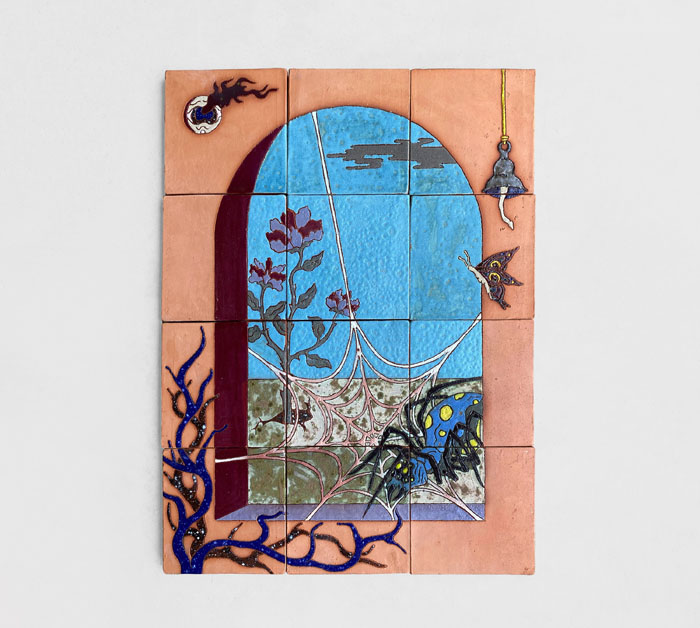
Charles Snowden
Senescent Stone
September 17 – October 29, 2022
Opening Saturday, September 17th, 3–7pm
Shulamit Nazarian is pleased to present Senescent Stone, a new series of free-standing and wall-based ceramics by Los Angeles-based artist Charles Snowden. This will be the artist’s first solo exhibition with the gallery.
Using symbolic imagery from antiquity and everyday life, Snowden’s ceramic sculptures reflect on the cycles of life and death. Invoking ancient rituals, he recasts apotropaic objects—protective forms intended to ward off threats of evil or harm—with imagery from nature. Senescence refers to the process of deterioration with age, indicating the loss of a cell’s power for division or growth. With the garden as a site for the investigation of mortality and clay as a material synonymous with the body, Senescent Stone recalls historical imagery as a vehicle for understanding the temporal nature of our existence.
At the center of the gallery, a number of sculptures are arranged on an elliptical plinth that equally references a table and a tomb. In lieu of the ceramic amphorae used in the Greco-Roman context to contain food, drink, and remains of the deceased, Snowden substitutes enlarged, gesturing hands as vessels for garden creatures. Frogs and butterflies stand in for symbols of metamorphosis, while other organisms carry the role of transformation deeper. Snakes and spiders, for example, imply a constant duality: by consuming and threatening other living things, these predators create greater harmony in gardens. Here, growth and transformation are in lockstep with decay and deterioration, a process that echoes the creation of clay from stone in ceramics. Snowden composes his objects to hint at this delicate divide: an egg, cracked to reveal a glancing eye, rests on a single knuckle; a skull with butterfly wings hangs in suspense by a rope; and, in the exhibition’s namesake sculpture, a massive foot balances tip-toed on a lumpy, lily pad-dwelling toad.
The existential weight of apotropaic objects and accompanying rituals is counterbalanced with humor across several pieces. In Harbinger, a snail’s face is replaced by a human one, but with dog ears. Another snail morphs into a human hand reaching for a worm-stuffed dog toy in Slow Journey. Though these absurd chimeras are nonsensical, they capture the pathos of Snowden’s practice. He shares, “I imagine possibilities within the relationships between the human, non-human and by extension non-living world to cultivate experiences that feel regenerative and playful, yet melancholic.”
In a series of additive reliefs on the surrounding walls, Snowden again turns to historical rituals that engage with mortality relative to the body and garden. These works appropriate an ancient Roman ritual in which floors covered in food scraps were left unswept, leaving the food to spoil as a memento mori and an offering for those passed. In Nodding Tendril, worms burrow through fruits and vegetables littered over patterned tile as vines spring from holes in the stone, suggesting a flourishing ecosystem below the architecture. Another unswept floor, Star Eater, takes the scene to a different plane altogether: the familiar snail and toad are caught in a spider’s web alongside a human ear and a chicken foot. A spider and its web take primary focus in a third tile work, screening a window that opens to a vividly glazed skyscape.
While rooted in research into sociohistorical and sociocultural practices, the works gesture towards a temporality beyond reach. Centuries old imagery is presented alongside dog toys and rope, with vines and snails weaving through historical and contemporary symbols alike. Various applications and omissions of glazing create a rhythmic shift between textural terracotta and brilliant color, further emphasizing the different histories of the artist’s chosen medium. This circuit of haptic and optic experience echoes the nature of mortality: death begets life begets death and so on.
Snowden mines historical rituals both for their connection to the regenerative processes at work within nature, as well as the symbiotic relationship between life, death, and decay. At the intersection of sculpting, gardening, and apotropaic ritual, the works in Senescent Stone confront the body’s inextricable link to nature and mortality. The hand itself, in tending to the garden and sculpting clay, becomes a votive object that dismantles the notion that there is any separation between us and the natural world. Revitalizing an awareness that all things—human, non-human, and non-living alike—contain transformative potential, Senescent Stone asks us to reconcile our conceptions of life with this reality of existence.

